Draft Energy Strategy and Just Transition Plan
We are consulting on this draft route map of actions we will take to deliver a flourishing net zero energy system that supplies affordable, resilient and clean energy to Scotland’s workers, households, communities and businesses.
Chapter 2: Preparing Scotland for a just energy transition
By 2030, Scotland will have an energy system that provides maximum community and economic benefits. We will have seen investment in green energy that delivers economic opportunities. Workers will have the training, skills and opportunities to access the good, green jobs that come with this. The energy market will be fairer, and costs will be distributed equitably. Home-grown clean energy provision will be maximised, limiting our exposure to the effects of global energy price shocks.
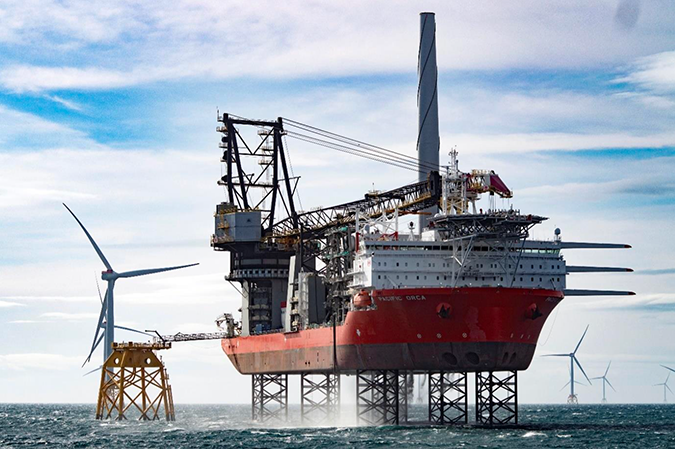
Photo credit: Highlands and Islands Enterprise
The energy transition offers significant opportunities for Scotland, including domestic and international businesses and industries investing in Scotland, and is essential to delivering on our wider net zero ambitions. We must also make sure that it delivers for the people, workers, communities and economy of Scotland.
This chapter sets out the actions we will take to prepare Scotland for a Just Energy Transition. The actions are part of a draft Just Transition Plan for the energy sector which we will develop and refine with businesses, trade unions, workers and communities in the coming months.
The purpose of Just Transition Plans is to:
- maximise the economic benefits of Scotland's transition to net zero, including ensuring a pipeline of skills for net zero jobs;
- ensure fair distribution of opportunities, benefits and risks, including consideration of community benefits, and how to adapt to the impacts of climate change; and
- ensure an inclusive and fair process via co-design with stakeholders, trade unions and the public.
In Scotland, our Just Transition Planning Framework sets out eight national Just Transition Outcomes[17], these have been distilled into the energy sector specific outcomes which can be found in Annex F. These outcomes will be shaped further through additional co-design with stakeholders, trade unions and the public, and through the consultation on this draft Strategy and Plan.
Given that this is a joint Energy Strategy and Just Transition Plan, this document will look quite different to other sectoral Just Transition Plans. In the first half of 2023, a series of outline draft Just Transition Plans for Buildings and Construction, Land Use and Agriculture and Transport will be published. These drafts will then be tested and refined following an extensive co-design process. All Just Transition Plans will demonstrate how we will maximise the economic opportunities for Scotland.
This draft Energy Strategy and Just Transition Plan outlines how we will do this including growing net zero energy sectors, supporting communities, workers, citizens and businesses, driving investment and increasing trade opportunities. The people of Scotland must reap the economic benefit of the energy transition, and this chapter sets out how we will leverage government expenditure to support these ambitions. We are also working with partners across the Grangemouth Future Industry Board to deliver a Just Transition Plan for the Grangemouth Industrial Cluster.
This chapter should be read alongside further sector detail in Chapters 3-5 and specifically the Just Transition section of the North Sea Oil and Gas section in Chapter 3.
We will take the following actions:
Delivering a just transition for communities and regions across Scotland
People have access to affordable clean energy
We have doubled our Fuel Insecurity Fund this year to £20 million, helping households who are at risk of severely rationing their energy use or self-disconnecting entirely.
We will boost the Home Energy Scotland (HES) advice service and have widened the eligibility criteria of the Warmer Homes Scotland fuel poverty programme.
We continue to call on the UK Government to take stronger and more targeted action:
- A windfall tax should apply fairly to all companies benefiting from significantly higher profits.
- Additional support needs to be delivered to support vulnerable energy consumers who are already struggling to pay their bills and heat their homes.
- More needs to be done to support households across Scotland who rely on alternative[18] fuels to heat their homes.
- Accelerate the review on identifying 'vulnerable non domestic customers' and offer all vulnerable SMEs guaranteed support past March 2023.
We also continue to call on the UK Government to ensure continued incentives to support investment in renewable generation as well as enabling consumers, communities and businesses in Scotland to share the benefits of low-cost renewable power. (See Chapter 5 for more details).
Communities and places can participate in and benefit from the net zero energy transition
We will work with the renewables industry to explore ways of increasing the amount of shared ownership projects in Scotland.
We will encourage developers to offer community benefits and shared ownership opportunities as standard on all new renewable energy projects – including repowering and extensions to existing projects.
We are also working with the Scottish National Investment Bank to assess the pipeline of shared ownership opportunities and the ways in which they could be financed.
We are providing a tailored package of support to remote and rural off grid communities through CARES (Community and Renewable Energy Scheme), helping them to upgrade their energy systems.
We will commission a review to assess the current approach, identify examples of best practice for community benefits, and consider how we might further strengthen our approach and maximise the benefits flowing to communities.
We are currently updating our Good Practice Principles for Community Benefit from Offshore Renewable Energy Developments, and will consult on new draft guidance in 2023.
We will engage with the UK Government to consider mechanisms for maximising opportunities for community benefit and shared ownership for renewable energy developments.
We welcome UK Government proposals to consider how local communities can benefit from electricity infrastructure. We will work closely with the UK Government to ensure this policy reflects the diverse needs of industry and community stakeholders across Scotland.
We will work with enterprise agencies to help facilitate support to realise the vast regional socio-economic opportunities of the transition.
We will support six communities through the Carbon Neutral Islands programme to take net zero action locally.
We will carry out research on the net zero skills gap on islands across Scotland.
Through our Climate Action Hubs and Climate Action Towns, we will provide a vehicle for communities to come together to identify local solutions and build a pipeline of investible projects and opportunities at a regional level.
We will support local authorities to produce their Local Heat and Energy Efficiency Strategies and Delivery Plans by providing capacity support training in partnership with Zero Waste Scotland.
We are taking forward research into how to accrue maximum economic benefits to Scotland's households, communities and our economy at regional/local and national levels from Scotland's anticipated surplus low carbon energy.
Delivering a just transition for Scotland's energy economy
Creating a supportive policy environment and maximising the impact of government expenditure
We are investing almost £5 billion in the net zero energy economy in Scotland over this parliamentary term. Details can be found in Chapter 6 and available funding can be found in Annex I.
Our £75 million Energy Transition Fund supports five key transition projects in the North East and our £100 million Green Jobs Fund provides capital across Scotland to support green industries and the green jobs associated with them. Our £500 million Just Transition Fund will support the northeast and Moray to become one of Scotland's centres of excellence for the transition to a net zero economy.
The 2021-22 to 2025-26 Infrastructure Investment Plan (IIP) includes details of around £26 billion of major projects and prioritises enabling the transition to net zero as the first of its three core priorities. It provides a robust pipeline of public sector infrastructure work, with almost £9 billion for environmental sustainability and the net zero transition.
Attracting private investment
As part of our route map to a net zero energy system, we will develop an investment prospectus to support critical milestones. We will develop this in consultation with key stakeholders, including financial institutions, trade bodies and business, ahead of the finalised Strategy and Plan.
We will work with our enterprise agencies, business and investors to attract the required capital and inward investment to deliver Scotland's net zero ambition and export potential.
We have established the Green Heat Finance Task Force, working with partners to develop the additional financial products and services needed to unlock the heat in buildings transformation.
We will expand our Green Investment Portfolio to bring together market-ready projects worth £3 billion in 2022.
We will work with stakeholders, including the Scottish National Investment Bank, to ensure infrastructure investment is aligned to Scottish Government energy policy priorities and leverages private capital to help tackle climate change and support local economic growth.
In line with our National Strategy for Economic Transformation, an Investor Panel chaired by the First Minister has been established to bring market intelligence to Scotland's capital investment opportunities and will attract a pipeline of projects in Scotland that support our transition to net zero. The Panel met for the first time in Dec 2022.
We will publish an updated Climate Emergency Skills Action Plan (CESAP) in 2023.
Developing a multi-skilled green workforce, boosting jobs , our domestic supply chain and manufacturing capabilities
We are supporting the reskilling of oil and gas workers by funding an offshore skills passport through our Just Transition Fund.
To inform the updated CESAP, we are undertaking research on skills needs for hydrogen, heat in buildings and on Scotland's islands.
We have committed £100,000 in grant funding to support just transition capacity within the trade union movement.
We are making a £75 million investment in the National Manufacturing Institute Scotland (NMIS).
We are expanding our Supply Chain Development Programme to improve the capacity, capability and development of Scottish supply chains.
We are developing our understanding of Scotland's existing strengths in net zero goods and services and the renewables sectors, looking at opportunities for internationalisation.
The net zero energy system is continuously innovative and competitive in domestic and international markets
We will continue to improve our understanding of Scotland's renewable sectors' trade and investment needs and opportunities in order to set those out in the final Strategy and Plan, and are seeking views through this consultation.
We will publish our Renewables Export Plan in early 2023, to grow exports of renewable energy goods and services.
We will implement our Hydrogen Action Plan which was published in December 2022.
We will continue to urge the UK Government to create a frictionless trading environment for renewable energy, goods and services by using trade agreements and policies to address tariff and non-tariff barriers to trade.
We are calling on the UK Government to take the action necessary at a UK-level to facilitate the smooth international trade of hydrogen, in line with Scottish export ambitions.
We have funded an industry led study into the regulatory, infrastructure and economic requirements and benefits to establishing a CO2 shipping industry centred on Peterhead port.
We urge the UK Government to seek the development of a common international standard on CO2 storage that focuses on storing emissions from essential industries.
We will publish our Innovation Strategy, which highlights energy and low carbon as a key priority, in early 2023.
2.1 - People have access to affordable clean energy
Feedback from engagement
Stakeholders highlighted the importance of fairness and affordability, of ensuring that every household would get the energy they need at a fair price, and of providing support for those on lower incomes and those in, or at risk of, fuel poverty.
Recent increases in energy prices have had profound negative impacts on households and businesses across Scotland. In the absence of government support via the Energy Price Guarantee, the latest Ofgem price cap would see the typical GB household paying £4,279 per year. With government support, this will be £2,500 per year until April. This compares to £1,042 in winter 2022, an increase of over 100%. Most of the recent rise in fuel bills has been driven by prices increases in the wholesale energy markets, especially gas[19]. Prices for non-domestic consumers have also risen substantially, particularly for large industrial consumers in the UK who now pay some of the highest prices in Europe.
Impact of wholesale gas and oil prices on energy bills
Scotland is part of the GB energy system and GB gets around 35%[20] of its electricity demand from gas-fired power stations. The cost of gas therefore has a strong impact on the cost of electricity. In 2022, wholesale natural gas prices increased more than 6-fold from their long-term average, resulting in upward pressure on household energy bills. Independent analysis[21] showed that gas generation is approximately 9 times more expensive than renewables. Even assuming the highest cost estimates for grid integration of intermittent renewables (£30/MWh), gas generation was still almost 6 times more expensive than renewables[22]. We are clear that, as set out in Chapter 5, longer-term, the UK Government must reform the energy market to permanently break the link between the price of electricity and the cost of gas and enable the benefits of home grown low-cost renewable power. Scotland's status as a fossil fuel producer has not insulated Scotland from the associated energy cost crisis because prices are set by international markets and Scotland's offshore gas reserves are too small to meaningfully change global gas prices. Scotland was responsible for 1% of global oil and gas production in 2019.[23] Oil and gas prices have surged since countries started to recover from the Covid pandemic and Russia invaded Ukraine.
Although bill payers remain protected from the full increase by the UK Government's Energy Price Guarantee and Business Energy Bill relief schemes, the increase in energy bill costs is still putting significant pressure on household and business finances, with many unable to afford the energy they need. Thousands of families and businesses are facing an acute crisis, with risks of escalating debt, self-disconnection, self-rationing of vital energy services, and businesses being forced to close temporarily or collapsing completely.
Consumer Scotland[24] has a key part to play in our journey to net zero. Their strategic plan and work plan due to be published in 2023 will have net zero as a key priority. Their recent energy affordability tracker[25] found that:
- 36% of consumers reported that they are not managing well financially
- 43% cannot heat their homes to a comfortable level
- 69% are finding it more difficult than last year to keep up with energy bills – rising to 82% for prepayment customers
- 68% are reducing the use of electrical appliances because of financial concerns.
We will continue to do all we can to support households and businesses, and our priority is those in or at risk of fuel poverty[26]. A number of our delivery programmes have been escalated to respond to the cost of living crisis. We have:
- Doubled our Fuel Insecurity Fund to £20 million for 2022-23, which we know is making a real and tangible impact on the ground now, through our delivery partners, towards helping the most vulnerable in society. This has been, and continues to be a lifeline for thousands of households, against rising energy prices which will only continue into this year.
- Expanded the Home Energy Scotland (HES) service, increasing its capacity by 20%, supporting an additional 12,000 households. Boosted HES Energy Carers, more than doubling capacity (to support 1,400 vulnerable households).
- Increased per-property funding limits within our local authority-led Area Based Schemes to enable more projects to go ahead despite inflation impacts on materials and labour, and to keep customer contributions down.
- Introduced an insulation-only stream to our Warmer Homes Scotland (WHS) Programme for working-age people without children on low-income benefits, who were not previously eligible.
- Widened the eligibility criteria for Warmer Homes Scotland (WHS) to more households in the 60+ yrs age groups.
- Launched a national marketing campaign over winter 2022-23 to raise awareness of Home Energy Scotland and the support on offer for energy efficiency.
- Introduced a standalone grant to replace the cashback element of Home Energy Scotland (HES) Loans for domestic owner occupied properties. The new grant provides funding for heat pumps up to £7,500 and for energy efficiency improvements – up to 75% of the combined cost of the improvements and up to the maximum grant amount of £7,500.
- Applied a rural uplift of £1,500 to both the heat pump and energy efficiency grants. This uplift increases the heat pump grant flat rate and the maximum limit of the energy efficiency grant to £9,000.
- Invested an additional £300,000 to improve the capacity of Business Energy Scotland. We have also committed to introduce a stand-alone grant this financial year to improve financial support to SMEs to help them decarbonise.
We continue to call on the UK Government to take stronger and more targeted action to support households and businesses:
- A windfall tax should apply fairly to all companies, not just energy companies, benefiting from significantly higher profits.
- We have highlighted repeatedly the need for extra support for vulnerable energy consumers who are already struggling to pay their bills and heat their homes.
- More needs to be done to support households across Scotland who rely on alternative fuels[27] to heat their homes.
The UK Government's higher price cap from April 2023 (proposed average of £3,000) for domestic consumers is still unsustainable for many households, and we estimate that it will put around 970,000 Scottish households in fuel poverty. We continue to call on the UK Government to provide additional support, especially for consumers reliant on alternative heating fuels. It is essential that those households and businesses not classified as fuel poor or vulnerable, but for whom soaring costs remain a huge concern, continue to receive some support. We also call on the UK Government to ensure continued incentives to support investment in renewable generation, as well as enabling consumers, communities and businesses in Scotland to share the benefits of low cost renewable power. (See Chapter 5).
The current market volatility and the ongoing reserved nature of powers on energy regulation and the energy market mean that now is not the right time for a retail-based public energy company.
A national public energy company that is involved in major energy generation would only be possible in an independent Scotland where we had full powers over the energy market and full access to borrowing.
2.2 - Delivering for communities and regions across Scotland
This is a national Strategy and Plan, but much of the action to deliver Scotland's energy transition will happen at a local and regional level. Scotland has diverse communities with differing needs, and the draft Strategy and Plan must deliver for all parts of Scotland.
The just energy transition needs to meet the needs of different communities and workers, and deliver on the opportunities offered by different geographies and infrastructure assets. For areas of Scotland with traditionally higher dependence on fossil fuel related economic activity, such as the North East and Shetland, we will shift investment and employment to clean sectors such as wind and marine energy.
The opportunities that the transition creates are immense. This section sets out actions to support communities to ensure they derive maximum benefit from the energy transition, including through supporting regional hydrogen hubs and by getting involved in wider local and community energy projects, with the support of schemes such as the Community and Renewable Energy Scheme (CARES)[28].
The regional opportunities map (figure 10) highlights areas of activity across the energy system, demonstrating the diverse, Scotland-wide opportunity that the transition to net zero presents. For example, the energy transition presents strategic opportunities for the Highlands and Islands. The natural advantages offered by unparalleled wind, wave and tidal resources have made the region attractive to developers, and the past 20 years have seen significant growth in on- and offshore wind and notable advances in marine energy.
The waters around the coastline played host to the world's first deepwater offshore wind project – The Beatrice Demonstrator – ultimately leading to commercial-scale leasing rounds; most notably ScotWind. ScotWind puts the region at the global forefront of offshore wind, particularly floating wind. This will support the creation of highly skilled jobs, attracting new talent to the Highlands and Islands.
The Highlands and Islands also has significant opportunity for renewable hydrogen production, through repurposing and diversifying key oil and gas terminals, and capitalising on the region's vast offshore wind resource. With that comes huge potential to create green, fair and high-value jobs in remote, rural and coastal communities.
There are 93 inhabited islands in Scotland, with a population of 103,700[29]. The Islands of Rum, Eigg, Muck, Canna, Foula and Fair Isle are some of our smallest islands and all completely 'off-grid' (not connected to the national electricity or gas networks). These remote islands are looking at innovative ways to supply, distribute and generate energy including opportunities to ensure local maintenance and supply chain opportunities are realised. Our Carbon Neutral Islands programme will support some of this activity. We are supporting communities across Scotland to make the transition to low carbon and climate resilient living through regional climate hubs.
The North East of Scotland is a global centre for the energy industry. With more than 50 years of knowledge and experience in offshore energy, exploration and production, the area is recognised as a hub for energy innovation. As the energy industry evolves, the region is well placed to harness and deploy the existing skill set by securing new jobs and investment through the energy transition. Chapter 3 provides an updated Scottish Government position on North Sea exploration and extraction.
The South of Scotland is home to critical cross-border energy transmission infrastructure, has the potential to house hydrogen infrastructure, and is a significant exporter of power but imports hydrocarbons for heat and transport. The region's Energy Transition Plan will seek to use the South's green electricity strength to place the region in the vanguard of decarbonising heat and transport, production of green hydrogen, and securing supply chain jobs. South of Scotland Enterprise is leading development of a Net Zero Route Map for achieving the region's just transition prior to 2045, and the first related sectoral transition plan will be for Energy.
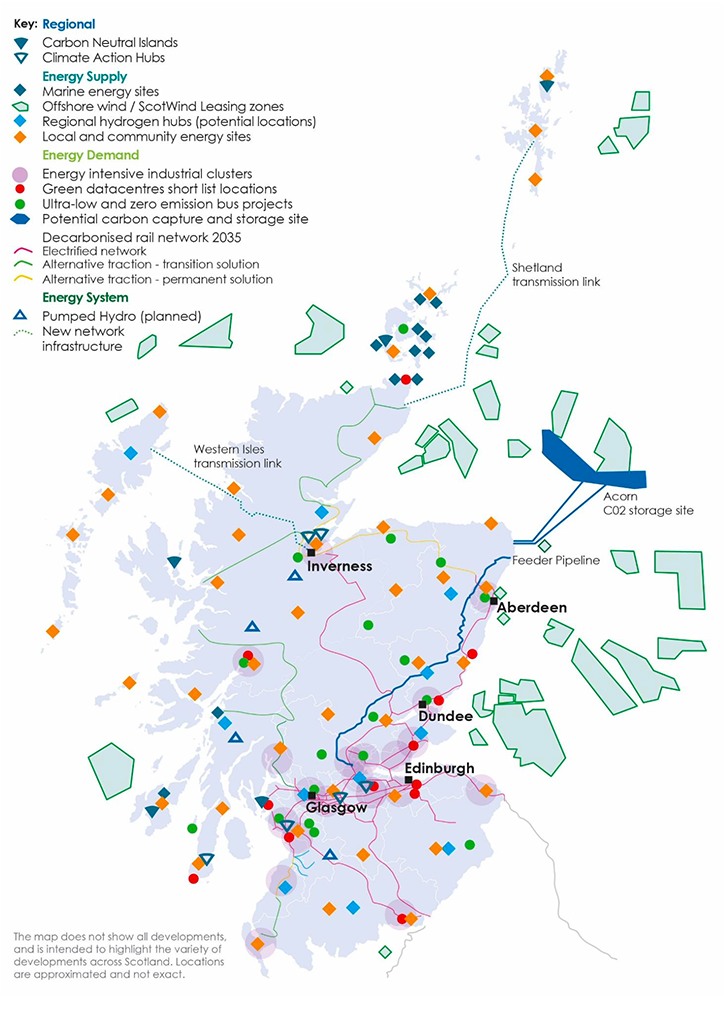
Benefits to climate and our environment
A just transition must support Scotland's ambitions for restoring and regenerating biodiversity and improving the health and quality of our natural environment. Any trade-offs between the energy transition and nature goals must be carefully assessed and managed. Our Environment Strategy sets out the Scottish Government's commitment to tackling the twin climate and nature crises. It highlights that these crises are intrinsically linked, and it is essential to take a joined-up approach to tackling them. This includes adopting nature-based solutions to energy that also support biodiversity.
Securing positive effects for biodiversity is one of six statutory outcomes for our National Planning Framework 4 (NPF4), which signals a turning point for planning.
2.2 - Community energy and shared ownership
Feedback from engagement
Stakeholders called for communities to be empowered by, and supported through, the energy transition. This includes exploring models of shared ownership, mandating a level of local content in every major energy project, delivering community-owned energy generation through local authorities and establishing a community benefit framework with clear criteria to make sure the right benefits reach the right communities.
Communities across Scotland must get maximum benefit from the energy transition, and community and shared ownership of renewables is an important tool to help achieve this. Scotland already has a positive legacy of community and local ownership of energy which provides a firm foundation to build on. (See figures 11 and 12).
Community and shared ownership of energy provides revenue that can be directly invested back into the local community, and community benefit from renewables projects can make a real and lasting difference to local communities. Whilst the Scottish Government does not have powers to mandate community benefit – or shared ownership – our voluntary community benefit register[30] indicates that a community benefit commitment of around £24 million will have been paid out from renewable energy projects in Scotland over the past 12 months.
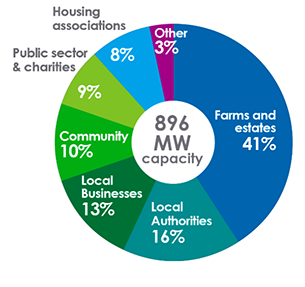
Source: Community and locally owned energy in Scotland report[31]
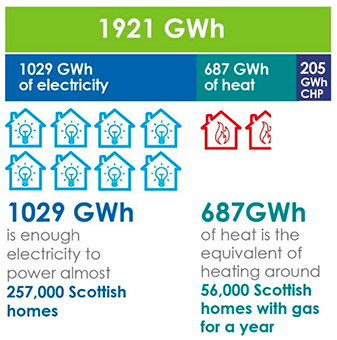
Source: Community and locally owned energy in Scotland report[32][33]
Case study: Strathnairn community benefit fund.
Strathnairn Community Benefit Fund (SCBF) was set up in 2004 to receive and distribute community benefit payments from the developer of the Farr Windfarm, Npower UK (now owned by Ventient Energy) and the Farr Hydro Scheme. The annual fund value was over £230k in 2018. SCBF has funded projects, including: community transport provision, after-school activities for children, and running costs for community halls. It has also provided grants to make homes of residents more energy efficient, install renewables, and to help residents pay their fuel bills through The Energy Grant, which was introduced in 2015.
All developers of renewable energy developments and local communities in receipt of community benefit payments are encouraged to use and input to the register. The community benefit map and register, which provide a breakdown by project, can be viewed via the following link: https://localenergy.scot/community-benefits-map/
We are working with the renewables industry to explore ways of increasing the amount of shared ownership projects in Scotland. We are encouraging developers to offer community benefit and shared ownership opportunities as standard on all new renewable energy projects – including repowering and extensions to existing projects.
Case study: Shared ownership of renewables – Crossdykes wind farm
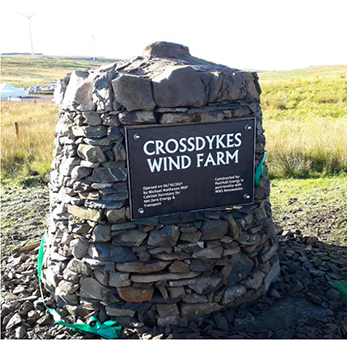
Photo Credit: Local Energy Scotland
Crossdykes Wind Farm is a 48 MW onshore wind power project. It is located 11km North-West of Langholm and 13km North-East of Lockerbie. It has the capacity to generate enough green electricity to power 45,000 homes.
Developed by Muirhall Energy, Crossdykes Wind Farm is the first in Scotland where the community have a share in a subsidy-free wind farm. It will also deliver £7,000 per MW in community benefit fund payments each year, leading the way in developer-led community investments. Photo credit: Local Energy Scotland
Muirhall Energy's Community Shared Ownership scheme, with the local community taking a five percent stake in the project, will ensure a significant income stream of around £4 million over the lifetime of the wind farm and is the largest community investment in renewables since 2017.
Residents local to Crossdykes Wind Farm will also benefit from an annual pot of £322,000, amounting to £8 million over the lifetime of the project.
Our CARES scheme provides support to communities and developers that are interested in shared ownership of a renewable project. This includes:
- Free, expert and impartial advice, including guidance on Financial Services and Markets Act and Financial Conduct Authority requirements
- Access to webinars
- Support to apply to funders e.g. Scottish National Investment Bank and Social Investment Scotland
- A shared ownership module in the CARES Toolkit
- The Indicative Finance Model – an interactive tool to give communities a better understanding of the project's viability
We're also working with the Scottish National Investment Bank to assess the pipeline of shared ownership opportunities and the ways in which they could be financed. Stakeholders agree that action is needed to further increase the benefits reaching communities. We will commission a review to assess the current approach, identify examples of best practice, and consider how we might further strengthen our approach and maximise the benefits flowing to communities.
We will continue to engage with the UK Government to consider mechanisms for maximising opportunities for community benefit and shared ownership for renewable energy developments.
We also welcome UK Government proposals to consider how local communities can benefit from electricity infrastructure. We will work closely with the UK Government to ensure this policy reflects the diverse needs of industry and community stakeholders across Scotland.
Supporting the global transition to net zero
We place great importance on Scotland being a good global citizen by playing our part in tackling global challenges including poverty, injustice and inequality. Energy plays a critical part in tackling these challenges, as it restricts human and economic development. Sustainable Development Goal 7[34] aims to ensure access to affordable, reliable, sustainable and modern energy for all.
There are currently 733 million people worldwide who lack access to electricity[35]; 77% of these live in sub-Saharan Africa[36]. In our partner countries the situation varies with only 15% of the population of Malawi, 45% of Zambians and 47% of Rwandans having access to electricity[37]. Energy provides economic and societal opportunities and clean energy is therefore at the heart of tackling climate change, whilst seeking to eradicate poverty. The Scottish Government's Global Renewables programme is seeking to support the global energy transition.
Case study: Global Renewables Centre
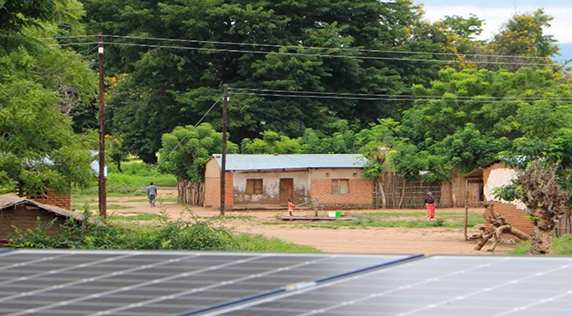
Photo credit: Aran Eales
The Scottish Government has committed to establishing the Global Renewables Centre (GRC). The GRC aims to support our international development partner-countries (Malawi, Zambia and Rwanda) in their transition to renewables. The focus of the collaboration is partner-country led, based on the needs they have identified. Our online hub will act as a knowledge sharing exchange between stakeholders in the partner countries and the Scottish renewables sector, opening up opportunities for networking and shared learning. In-country partnerships will support partners to access knowledge and support. As the GRC develops, we hope to open up the platform to a wider group of partners.
In September 2022 the Scottish Government signed up to the 24/7 Carbon-Free Energy compact (CFE), supporting rapid decarbonisation. We committed to treble the world-first Climate Justice Fund to £36 million over this parliamentary term and support the Women's Environment Development Organisation with £50,000 provided annually to support capacity building and training for women to engage in UNFCCC[38] talks and integrate gender equality considerations into the outcomes.
2.3 - Delivering a just transition for Scotland's energy economy
The energy transition offers significant opportunities for Scotland's economy, providing benefits for Scotland's people and communities. To maximise these benefits, we will secure private investment and seek to strengthen and support Scotland's companies, equip workers with the skills and opportunities to access good, green jobs, and explore opportunities to boost international exports.
Feedback from engagement
Stakeholders highlighted the need for action on supply chains and exports – with many voices calling for the Scottish Government to help provide the correct market signals and to propose a timetable for when critical components of the energy system are needed. This would ensure that home industries can scale up and invest to deliver transformation of the energy system, as well as harness the opportunities to export products and expertise around the globe.
Delivering a just transition requires an all-Scotland approach; it cannot be delivered by the Scottish Government alone. Our National Strategy for Economic Transformation, Inward Investment Plan and Global Capital Investment Plan show that working with businesses and investors, as well as public agencies, will be key to attracting the required high quality capital and inward investment, and technologies to deliver Scotland's net zero ambition and export potential. This inward investment will create opportunities for Scottish businesses and supply chains, increasing their access to global markets, technology and talent.
To harness the additional investment required to fund the just transition, where appropriate we will scale up activity to move from a funding to a financing policy model. This will more effectively leverage private sector investment and action to better amplify the impact of public investment.
This investment in Scotland's renewables potential will mean that we can ensure green energy self-reliance and also export increasing amounts of low carbon energy to our international neighbours, supporting the wider security of supply needs and decarbonisation ambitions of our neighbouring nations.
Creating a supportive policy environment and maximising the impact of government expenditure
We will use all the levers of government, including policy, investment and engagement with the UK Government to support Scotland's energy transition. We are already investing almost £5 billion in the net zero energy economy in Scotland over this parliamentary term (see Investment Route map in Chapter 6 for further details). We want to align our energy system outcomes with our investment, ensuring that we prioritise those projects which align with our future vision.
Our capital investment is primarily focussed on the demand sectors of heat, transport and industry. Under the current constitutional settlement, the Scottish Government is unable to invest in many parts of the UK's liberalised energy markets. We will continue to use our capital funds to support those least able to pay, to maximise economic opportunities for communities across Scotland and to promote environmental protection.
The public sector cannot do this alone: we need the private sector to work in partnership with the public sector to deliver the scale of investment required to enable the net zero energy transition. Investment should be anticipatory and coordinated to ensure we are building a future energy system that is fit for purpose and maximises strategic opportunities.
Maximising the benefits to our economy, businesses and workers
The National Strategy for Economic Transformation sets out the priorities for Scotland's economy, as well as the actions needed to maximise the opportunities of the next decade to achieve our vision of a wellbeing economy. The 2021-22 to 2025-26 Infrastructure Investment Plan (IIP) sets a long-term vision for infrastructure, supporting an inclusive, net zero carbon economy in Scotland. It includes details of around £26 billion of major projects and national programmes.
Attracting private investment
The Office for National Statistics (ONS) estimates that private investment in UK energy infrastructure reached £6.4 billion in 2020[39] (show in figure 13). Investment in our energy system generates wider supply chain benefits. For example, Offshore Energy UK (OEUK)[40] estimate for every £1 million of oil and gas GVA, £2.1 million is generated elsewhere in the economy. ScotWind will deliver over £750 million in revenues for the public purse through the initial awards alone, and developers have committed to invest an average of £1.4 billion per project, equating to more than £ 28 billion of potential investment in Scotland's supply chain.
We will work with stakeholders, including the Scottish National Investment Bank, to ensure infrastructure investment is aligned to Scottish Government energy policy priorities and leverages private capital to help tackle climate change and support local economic growth.
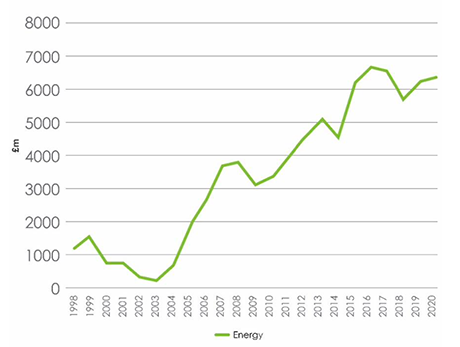
Source: Office for National Statistics Infrastructure in the UK, investment and net stocks - Office for National Statistics (ons.gov.uk)
We are already working with industry on financing solutions. As well as the investment in hydrogen, CCUS and industrial decarbonisation set out below (see Chapters 3 and 4), we have established the Green Heat Finance Task Force, where we are working with partners to develop the additional financial products and services needed to unlock the heat in buildings transformation.
In line with our National Strategy for Economic Transformation, an Investor Panel chaired by the First Minister has been established to bring market intelligence to Scotland's capital investment opportunities and will attract a pipeline of projects in Scotland that support our transition to net zero. The Panel met for the first time in December 2022.
We will also expand our Green Investment Portfolio to bring together market-ready projects worth £3 billion in 2022. By assessing these projects before they go to market, the Portfolio provides investors with the confidence they need to back credible and sustainable projects in Scotland. As part of our route map to a net zero energy system, we will develop an investment prospectus to support critical milestones. We will develop this in consultation with key stakeholders, including financial institutions, trade bodies and business, ahead of the finalised Strategy and Plan.
As set out in the National Islands Plan, Scotland's islands will also play a key part in delivering net zero. The Scottish Government Carbon Neutral Islands (CNI) project will support six islands to progress towards becoming fully carbon neutral by 2040, including by developing investment strategies to leverage existing public funds, promote public-private partnership and drive private investment. Our delivery partner Community Energy Scotland is working locally on each island where community development officers have been employed to personally support the audit and plan phase of the Carbon Neutral Islands project.
Equipping our workforce with the right skills at the right time
Feedback from engagement
Stakeholders called for a clear plan, direction of travel and timetable for when the correct skills and jobs are required to deliver the energy transition at both a local and national level. They also asked for sustained and sufficient alignment between professional bodies, industry and bespoke training providers to deliver the workforce of the future.
The National Strategy for Economic Transformation set a 'Skilled Workforce' as one of the five policy programmes of action. Through this programme, we are committed to ensuring Scotland's workforce and employers have the skills they will need in the future, including the skills to support the transition to net zero. We recognise that sectors of the economy, and roles within these sectors, will face different challenges in the coming years, and that many individuals will need to upskill and retrain at various points in their career. This will put new demands on Scotland's education and skills system, as whole sections of the workforce may need support to transition into new or altered job roles.
In the immediate term, our priority actions, as set out in NSET, include:
- Establishing the purpose and principles for education and skills system reform and continuous improvement, and ensuring that they align with our wider socio-economic vision for Scotland;
- Enhancing the content and reach of the Green Jobs Workforce Academy;
- Developing a stronger, simplified lifelong learning system, including support targeted at those who need it most; and,
- Launching a Talent Attraction and Migration Service to help employers recruit workers from outside of Scotland to help address labour and skills challenges.
The Climate Emergency Skills Action Plan (CESAP) is central in defining our ambitions to create a future workforce that can support our transition to a net zero economy.
Just Transition Commission recommendation
A plan on the future of energy sector jobs must provide a clear picture of what the new energy economy will look like. This will help identify future opportunities, what skills will be prized, and where jobs will be located.
We will publish an updated CESAP in 2023, reflecting this draft Strategy and Plan, and setting out next steps for the Green Jobs Workforce Academy. All sectoral Just Transition Plans will expand on the actions we will take to deliver the priorities of our updated CESAP.
We are already seeing the employment benefits from the development of Scotland's offshore wind sector. Scotland is the best performing UK region in the Green Jobs barometer[41], a tool to track job creation, wider employment benefits, job loss, carbon intensity of employment, and worker perceptions with relevance to the green transition.
There are an estimated 20,500 people employed in the Low Carbon and Renewable sector in Scotland, which has an estimated turnover of over £5 billion[42]. Further information on the employment trajectory of the energy production sector, as part of the programme of work conducted on the future of the North Sea, can be found in Chapter 3.
Case study: AMTE Power

Photo Credit: AMTE Power
AMTE Power Plc took over the dormant AGM Batteries Ltd factory in Thurso with the support of Highlands and Islands Enterprise. Their vision focussed on the key role that new battery cell technology would play in the transition to net zero. AMTE now have over 70 employees and have announced an agreement with the UK Battery Industrialisation Centre for the manufacture of its Ultra High Power cells to support commercialisation into the automotive market.
Case study: Scottish Trade Union Congress (STUC) funding for a just transition
We have committed £100,000 in grant funding to support just transition capacity within the trade union movement. The unions – primarily through the Just Transition Commission – have been fundamental to our policy thinking about a just transition. This funding will provide dedicated worker engagement roles within the STUC to support just transition planning across all Just Transition Plans, delivering enhanced levels of worker engagement in the next phase of co-design for the Energy Strategy and Just Transition Plan. It will also help to bring fair work considerations more fully into our work.
Boosting our domestic supply chain and manufacturing capabilities
Strong supply chains are crucial to ensure we capitalise on the economic opportunity from the transition to net zero. Manufacturing accounts for over half of Scotland's international exports, 47% of businesses' expenditure on research and development (R&D) and 178,000 jobs[43]. We must maximise the use of Scottish manufactured components in the energy transition and ensure high-value technology and innovation.
Making Scotland's Future draws together enterprise and innovation support from across the public sector with an explicit focus on strengthening supply chains. Supporting Making Scotland's Future is our £75 million investment in the National Manufacturing Institute Scotland (NMIS), an industry-led international centre of expertise aimed at making Scotland a global leader in advanced manufacturing. NMIS is already working with firms across Scotland to transform manufacturing skills, productivity and innovation.
Our National Strategy for Economic Transformation (NSET) sets a number of priorities for action, including supporting Scottish supply chains, and laying the foundations of a Net Zero Industrial Strategy (Project 6), with actions to: expand our Supply Chain Development Programme to improve the capacity, capability and development of Scottish supply chains, including identifying Scottish companies with the skills, capacity and capability to bid for, win and deliver contracts in key industries; adopt a cluster building approach to strengthen our position in new markets; and, review our strategic approach to public ownership so that public companies are managed, developed and initiated for the public good, and work collaboratively to provide support and advice to establish successful public companies.
Case study: Manufacturing in Scotland
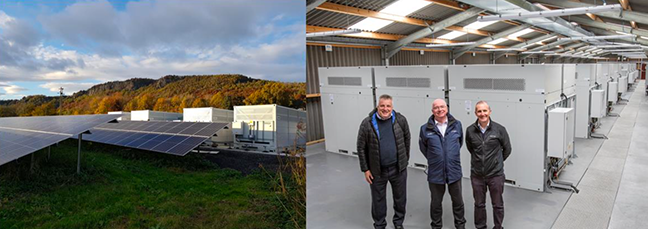
Photo Credit: Invinity: (Left) Invinity's VFBs at Scottish Water Perth site and (Right - Credit, Colin Keldie, EMEC) Graeme Harrison HIE, Neil Kermode EMEC and Cabinet Secretary for Net Zero, Energy and Transport, Michael Matheson MSP at EMEC in front of Invinity's flow battery
Invinity Energy Systems' vanadium flow batteries (VFB), manufactured and assembled at the company's Bathgate facility in West Lothian, are accelerating global progress towards net zero at sites all over the world, including two ground-breaking projects in Scotland. Invinity's VFBs are fully recyclable and are a leading alternative to lithium-ion technology. The company has a strong commitment to a just transition to renewable energy with no-one left behind and employs a growing number of highly skilled staff who were previously employed in the oil and gas sector, bringing their fossil-fuel expertise into the green economy.
Our Supply Chain Development Programme seeks better economic impact from Scotland's annual £13 billion public sector procurement spend and focusses on opportunities that will arise in the energy transition. Current priorities include the manufacturing opportunities from heat pumps, hydrogen electrolysers and component parts. See Chapter 4 for support for low carbon manufacturing.
International opportunities – trade and inward investment
The energy transition offers significant trade and investment opportunities, including through trade in energy, services, technology and supplies, and inward investment. This is embedded in the Scottish Government's key trade and investment plans, and our vision of the future for our economy. Energy is a critical sector for export growth within A Trading Nation. We are developing sector export plans on renewables and hydrogen, which set out how energy can continue to be a critical export growth sector as we make the transition to net zero.
Our inward investment plan, Shaping Scotland's Economy, commits to taking a values-led approach to inward investment and includes energy transition as one of the nine opportunity areas for Scotland. Inward investment makes a disproportionately positive contribution to Scotland's economy by attracting the high-quality technologies, know-how, skills and jobs required in emerging areas of energy transition and the decarbonisation of transport, underlining its importance in achieving a just transition.
Scottish Enterprise's Framework for Net Zero sets out how we are mobilising enterprise agencies' expertise, influence, networks and funding to help shape and accelerate Scotland's net zero economic transition. This includes unlocking key net zero market opportunities for Scottish businesses including decarbonised heat, the hydrogen economy, heavy duty electric vehicles and offshore wind.
Scotland's Vision for Trade included a commitment to end all Scottish Government's routine overseas trade support and promotion activities solely focused on fossil fuel goods and services in time for COP26 (1 November 2021). This is a refocussing of support, not a reduction, and is designed to support businesses transitioning away from solely fossil fuel related exports.
We will continue to improve our understanding of Scotland's renewable sectors' trade and investment needs and opportunities in order to set those out in the final Strategy and Plan, and are seeking views through this consultation.
We will publish our Renewables Export Plan shortly after this draft Strategy and Plan, to grow exports of goods and services. This will include international sales of goods, and the provision of services to customers outwith the UK, related to energy produced from renewable sources, including hydro power, marine energy, solar energy, wind energy, bioenergy, and renewable heat (such as geothermal). We also published our Hydrogen Action Plan in December 2022.
We are urging the UK Government to create a frictionless trading environment for renewable energy, goods and services by using trade agreements and policies to address tariff and non-tariff barriers to trade. We are also calling on the UK Government to take the action necessary at a UK-level to facilitate the smooth international trade of hydrogen, in line with Scottish export ambitions.
Innovation
Just Transition Commission recommendation
Clusters of test and demonstration sites that build on existing capabilities and deliver supply chain diversification should be established to accelerate innovation, and develop affordable solutions fit for design, manufacture and installation in Scotland.
We want to promote Scotland as an innovation test bed for new technologies and markets. Our forthcoming Innovation Strategy will describe how we will stimulate innovation in renewable and hydrogen technologies, and in the decarbonisation of transport, heat and energy efficiency.
Case study: energy systems innovation – whole energy systems accelerator (WESA)

Image credit: PNDC
The WESA project is a collaboration between Energy Systems Catapult 'Living Lab' and the University of Strathclyde's Power Networks Demonstration Centre. It aims to build and operate a first-of-a-kind, agile and scalable real-world trial and demonstration. It estimates that within 10 years around 90 companies (mainly SMEs) will have been supported and 39 new products commercialised, creating over 2,900 highly skilled jobs and over £129 million gross value added in Scotland. This project has been supported through the Scottish Government Green Jobs Fund.
Contact
Email: energystrategy@gov.scot
There is a problem
Thanks for your feedback